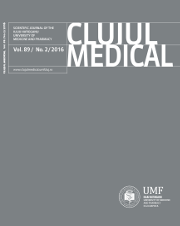The relevance of personality assessment in estimating the risk of onset and the outcome of major depressive disorder
DOI:
https://doi.org/10.15386/cjmed-563Keywords:
major depressive disorder, personality assessment, temperament, characterAbstract
The study of the relationship between the psychobiological model of temperament and character on one side and the development and evolution of major depressive disorder on the other side has drawn some attention in the past two decades, especially since a diagnosis model based on fewer diagnostic categories and a more phenomenological and person oriented approach seems to be supported other research and current state-of-the art therapeutic practices, which are based more on descriptive clinical data than on the current diagnostic categories.
The aim of this paper was to review the latest developments in this area, but in the context of the initial development of the psychobiological model of temperament and character, i.e. as a tool for the comprehensive diagnosis of depressed individuals.
Data published so far supports the following observations: (1) high harm avoidance and low self-directedness are risk factors for the development of major depressive disorder, but further research is needed to clearly establish the role of the other dimensions or their facets as predictors for the development of a depressive episode; (2) although some evidence has been obtained so far regarding the use of harm avoidance, novelty seeking, reward dependence and cooperativeness in predicting treatment response in major depressive disorder, further research is needed to clarify and/or to replicate these findings; and (3) data on temperament and character dimensions related to relapse in major depressive disorder are insufficient, although some evidence has been brought to support the hypothesis that high harm avoidance scores, and low self-directedness and novelty seeking scores might serve as predictors, further prospective studies need to be carried out to establish their utility in this respect.Downloads
Additional Files
Published
How to Cite
Issue
Section
License
The authors are required to transfer the copyright of the published paper to the journal. This is done by agreeing to sign the Copyright Assignment Form. Whenever the case, authors are also required to send permissions to reproduce material (such as illustrations) from the copyright holder.

The papers published in the journal are licensed under a Creative Commons Attribution-NonCommercial-NoDerivatives 4.0 International License.

